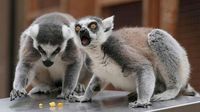It was a bustling scene at London Zoo this week as animals of every size, from hulking Galapagos tortoises to minuscule snails, took their turn on the scales for the annual weigh-in. The event, which took place on August 20, 2025, is not just a quirky spectacle for visitors—it’s a vital health check for the more than 400 species that call the historic zoo home.
According to the Associated Press, keepers enticed their charges with treats like fish, carrots, and cabbage, coaxing everyone from penguins and lemurs to capybaras and giant tortoises to step onto the scales. It’s not every day you see a tortoise weighing over 200 kilos waiting patiently for a carrot reward, but at London Zoo, that’s exactly what happens each summer.
The weigh-in isn’t just for show. As reported by Africanews, the keepers carefully record the weight and measurements of each animal, updating crucial health data that is then shared with conservationists around the globe. Every measurement is meticulously logged into the global Zoological Information Management System, a database used by zoos and conservation projects worldwide. This allows for the monitoring of individual animals’ growth, the tracking of pregnancies, and the early detection of any changes that could signal health issues.
“The weigh-in helps monitor growth, track pregnancies, and detect changes, providing information used not only at the zoo but also for conservation work in the wild,” Africanews explained. This means the data gathered isn’t just helping the animals in London—it’s contributing to the survival of species everywhere.
The diversity of animals participating is staggering. As detailed by the AP and other outlets, the line-up included everything from the aforementioned Galapagos tortoises—some tipping the scales at well over 200 kilos—to tiny snails that weigh just a few grams. Penguins, lemurs, and capybaras were also among the more than 400 animals checked during the week of August 18 to August 22, 2025. Each animal’s data is another piece of the puzzle in understanding and protecting wildlife.
For the keepers, the weigh-in is both a logistical challenge and a highlight of the year. Tempting a capybara onto a scale with a handful of carrots is one thing, but convincing a nervous lemur or a skittish penguin requires patience, trust, and a bit of creativity. “It’s always a bit of a circus, but in the best possible way,” one keeper was overheard saying to a visitor, according to BBC coverage of previous years’ events. The process is designed to be as stress-free as possible for the animals, with familiar keepers, favorite foods, and plenty of positive reinforcement.
But why go to all this trouble? The answer lies in the critical role zoos play in conservation. As AP and Africanews both highlighted, the data collected during these weigh-ins is shared with scientists and conservationists working to protect endangered species in the wild. Changes in an animal’s weight or size can be an early indicator of health problems, pregnancy, or even environmental stressors. By keeping detailed records over many years, zoos like London can spot trends and respond quickly to any issues.
“Each animal, ranging from penguins and lemurs to capybaras and Galapagos tortoises, is carefully logged into the global Zoological Information Management System,” Africanews reported. This international database is a crucial tool for managing captive populations, coordinating breeding programs, and ensuring genetic diversity. For species on the brink of extinction, such as some tortoises and amphibians, these efforts can mean the difference between survival and oblivion.
London Zoo’s annual weigh-in has become something of a tradition, drawing attention not only to the zoo’s residents but also to the broader challenges facing wildlife worldwide. The event offers a rare behind-the-scenes look at the detailed care that goes into maintaining a healthy, thriving animal collection. It also highlights the zoo’s commitment to scientific research and global conservation efforts.
Visitors lucky enough to witness the weigh-in get a glimpse of the zoo’s quieter, more methodical side. While the spectacle of a giant tortoise lumbering onto a scale or a troop of lemurs lining up for their turn is certainly entertaining, it’s the careful note-taking, gentle coaxing, and scientific rigor that truly stand out. The keepers’ dedication is evident in every carefully logged entry and every reassuring pat on the shell or feathered back.
For the animals, the weigh-in is just another day at the zoo—albeit one with a few extra treats. For the keepers and conservationists, it’s a vital part of a much larger mission. As the data from this year’s event is entered into the global system, it will join millions of other records, helping to build a clearer picture of animal health, behavior, and needs across the world.
“Keepers recorded the weight and measurements of more than 400 animals, updating vital health data that is shared with conservationists worldwide,” as reported by multiple outlets. This careful, painstaking work may not make headlines every day, but it forms the backbone of modern wildlife care and conservation.
In a world where many species face unprecedented threats from habitat loss, climate change, and disease, the work done at London Zoo—and at zoos and conservation centers everywhere—has never been more important. The annual weigh-in is a reminder that every animal counts, from the tiniest snail to the mightiest tortoise, and that careful observation and record-keeping can have a ripple effect far beyond the zoo’s walls.
So, as the last animal steps off the scale and the keepers finish their notes for another year, the real work continues. The data will be analyzed, shared, and put to use in conservation projects around the world. And next year, the scales will be ready once again, waiting for a new round of animals—and a new chapter in the ongoing story of wildlife care and protection.




